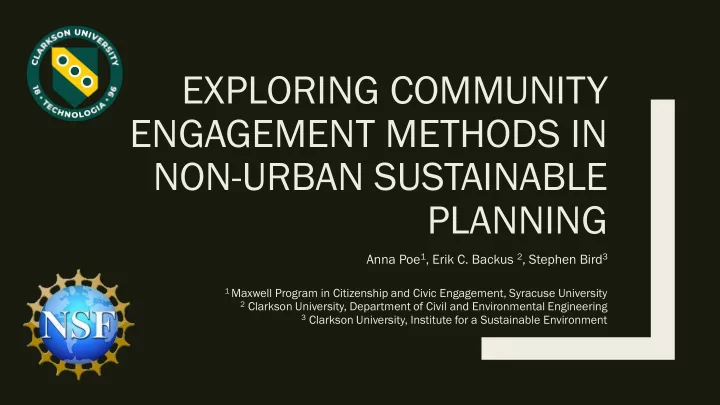

EXPLORING COMMUNITY ENGAGEMENT METHODS IN NON-URBAN SUSTAINABLE PLANNING Anna Poe 1 , Erik C. Backus 2 , Stephen Bird 3 1 Maxwell Program in Citizenship and Civic Engagement, Syracuse University 2 Clarkson University, Department of Civil and Environmental Engineering 3 Clarkson University, Institute for a Sustainable Environment
Background ound ■ Sustainability has become an increasingly important component of urban development ■ U.S. Green Building Council → LEED for Communities, LEED for Cities ■ Smart Growth America → Complete Streets ■ Sustain ainab able le Holistic ic Planning ing Systems (SHPS) – Comprehensive approach to community action and decision making – Metric-based – Tackle problems of climate change in ways that are “smart and connected” (Backus et. al)
Non-Urb Urban an Communiti nities es ■ The problem? – Focus toward urban development and neglect an equally important sector: the non-urba rban – encompassing both properties of peri-urban spaces and rural small towns. “Peri -urban defines the transect of space Peri- between town and Rural al Ur Urban an country. It is a rural- Ur Urban an urban landscape interface or transition zone beyond the urban.” (Backus, et al.)
Non-Urban: Different Characteristics= Different Planning Needs Declining Higher levels of Importance of downtown sectors/ Social Capital Natural Areas centralized activity Lack of Limited housing Less financial transportation choices capital options Re Resu sult: Large-Scale planning processes difficult to carry out Limited ed planning g capa paci city ty Effective solutions require combined efforts of all levels of government, business sectors, individuals, and the collective citizenry acting together. (Sheppard, et al., 2011 )
Research Question How effective are community engagement methods in sustainable planning processes in non-urban communities? • Community Engagement Key Considerations: • Going beyond community participation to include working collaboratively with relevant partners who share common goals and interests (Tindana et al, 2007). • Enhance Community Participation ( Fung, 2015)
Research Design How ow effe fectiv ctive e are community nity engagemen ement t met ethods ds in susta staina inabil bility ity planning nning pro roces esses ses in non-urba ban n communiti ities? s? Literatu ature e Review Action Ac on Resear arch Snow owball ball Communit nity Community ity Stakeh eholde older Questi tion onnaire naire Worksh shop op Intervi views ws
Complete e Street ets s in Gouverneu eur, , NY ■ St. Lawrence County, 7,074 pop ■ Most common jobs: construction and extraction, sales and related occupations, office and administrative support Complet mplete e Streets: eets: ■ Safer, more walkable communities ■ People and Place planning, design, construction, operation, and maintenance of transportation networks
Active Transportation & Complete Streets Workshop Commun munity ty Visio ion Increase # of Students Walking Fully occupied business on Main Street Uniform Sidewalks throughout Increased State of Good Repair Safe Access to School and Park Local Transit Development Education and Engagement Wayfinding Walk Audit Visioning Exercise SWOT Analysis and Prioritization
Snowball ‘Snowballing”: initial list of stakeholders propose further Stakeholder stakeholders, continuing the list of stakeholders in an expanding manner (N. R. Haddaway et. al). Interviews Qualitative sociological research strategy Goal: Utilize local networks to engage “Bottom - Up”, tapping into local networks, more nuanced approach stakeholders beyond those who were at the community workshop In progress: conducted 5 semi-structured interviews
Community Questionnaire ■ Developed 10-question questionnaire ■ Pop-up engagement ■ County Fair ■ 25 responses ■ Challenge: Context and audience
Key Findi dings ngs ■ Community Workshop: – Multiple stakeholders in the room at the same time resulted in productive conversations (development of Vision Statement, SWOT analysis). – Provided actionable data – BUT sample was not representative of entire community ■ Snowball Stakeholder Interviews: – Effective conversations, snowballing strategy worked well – Presence of a local elite culture (network didn’t expand beyond local leaders, decision -makers and influencers) ■ Key Challenge: Time / Resources
Questions for Further Consideration • What method of planning is most appropriate for a community (if at all)? • Is a formal planning system necessary? What ? •Which sustainable planning system is most appropriate for a community’s Which specific needs? One? • When is it best to engage the community in these planning efforts? • Throughout entire project? Project-by-project basis? When? How? • What is the best way to engage the public in these efforts?
References ■ Backus, E., Bird, S., Heintzelman, M., Mahapatra, S., Mosher, A., Powers, S., Skufca , J., “Analysis and Design of Tools to Enable Sustainable Holistic Planning Systems in Non- Urban Community Contexts” (White Paper, in development), 1 -3. ■ United States Environmental Protection Agency. (2014). What are some of the challenges facing Rural and Small Town America? [Ebook]. Retrieved from https://www.epa.gov/sites/production/files/2014-06/documents/ref_herman_081612.pdf ■ Tindana, P., Singh, J., Tracy, C., Upshur, R., Daar, A., Singer, P., & Frohlich, J. (2007). Grand Challenges in Global Health: Community Engagement in Research in Developing Countries [Ebook]. PLoS Medicine. Retrieved from https://journals.plos.org/plosmedicine/article/file?id=10.1371/journal.pmed.0040273&type=printable ■ Fung, A. (2015). Putting the Public Back into Governance: The Challenges of Citizen Participation and Its Future . The American Society for Public Administration. ■ “Future Visioning of Local Climate Change: A Framework for Community Engagement and Planning with Scenarios and Visualisation | Elsevier Enhanced Reader.” n.d. Accessed July 3, 2019. https://doi.org/10.1016/j.futures.2011.01.009. ■ Haddaway, N., Kohl, C., Rebelo da Silva, N., Schiemann, J., Spök, A., & Stewart, R. et al. (2017). A framework for stakeholder engagement during systematic reviews and maps in environmental management [Ebook]. Environmental Evidence. Retrieved from https://environmentalevidencejournal.biomedcentral.com/track/pdf/10.1186/s13750-017-0089-8
Acknowledgements ■ Support for Anna Poe was provided by NSF Award No. 1659623 (Advancing Sustainable Systems and Environmental Technologies to Serve Humanity (ASSETs to Serve Humanity).
Recommend
More recommend